Micro- and Nano-Roughness Separation Based on Fractal Analysis
Abstract
:1. Introduction
- to determine the largest dominant wavelength of the surface using three independent methods. The techniques used were: standard 2D roughness parameters (1), 2D PSD analysis performed on roughness profile (2), and slicing technique performed on 3D topography to identify roughness peak (3).
- to examine whether the fractal dimension values characterising the surfaces are the same in the case of 3D topographical measurements in different wavelength ranges, i.e., whether the bifractal and multifractal behaviours mentioned in the literature can be detected. There is no clear position in the literature in this regard. To determine the fractal dimension, a PSD analysis was performed on 3D topographic measurements.
- to determine the limit wavelength of each fractal domain in the case of different fractal dimension values (bifractal or multifractal behaviour). The literature currently does not provide a solution to this problem.
2. Materials and Methods
2.1. Measurement of Brake Plunger
2.2. Determination of the Dominant Wavelength
2.3. Fractal Analysis
3. Results
3.1. Dominant Wavelength
3.2. Fractal Analysis
4. Discussion
5. Conclusions
Author Contributions
Funding
Institutional Review Board Statement
Informed Consent Statement
Data Availability Statement
Conflicts of Interest
References
- Borodich, F.M.; Brousseau, E.; Clarke, A.; Pepelyshev, A.; Sánchez-López, J.C. Roughness of Deposited Carbon-Based Coatings and Its Statistical Characteristics at Nano and Microscales. Front. Mech. Eng. 2019, 5, 14. [Google Scholar] [CrossRef]
- Terres, M.A.; Ammari, L.; Chérif, A. Study of the Effect of Gas Nitriding Time on Microstructure and Wear Resistance of 42CrMo4 Steel. Mater. Sci. Appl. 2017, 8, 6. [Google Scholar] [CrossRef]
- Gong, Y.; Xu, J.; Buchanan, R.C. Surface roughness: A review of its measurement at micro-/nano-scale. Phys. Sci. Rev. 2018, 3, 20170057. [Google Scholar] [CrossRef]
- Seewig, J. Linear and robust Gaussian regression filters. J. Phys. Conf. Ser. 2005, 13, 254–257. [Google Scholar] [CrossRef]
- Krystek, M. Discrete linear profile filters. In Proceedings of the International Colloquium on Surfaces, Chemnitz, Germany, 31 January–2 February 2000; pp. 145–152. [Google Scholar]
- Svalina, I.; Sara Havrlišan, S.; Šimunović, K.; Šarić, T. Investigation of Correlation between Image Features of Machined Surface and Surface Roughness. Tech. Gaz. 2020, 27, 27–36. [Google Scholar] [CrossRef]
- Blateyron, F. New 3D Parameters and Filtration Techniques for Surface Metrology. Qual. Mag. 2006, 3, 1–7. [Google Scholar]
- VDA 2007. Oberflächenbeschaffenheit Definitionen und Kenngrößen der Dominanten Welligkeit; Verband der Automobilindustrie: Berlin, Germany, 2006. [Google Scholar]
- Persson, B.N.J.; Albohr, O.; Trataglino, U.; Volokitin, A.I.; Tosatti, E. On the nature of surface roughness with application to contact mechanics, sealing, rubber friction and adhesion. J. Phys. Condens. Matter 2005, 17, R1–R62. [Google Scholar] [CrossRef]
- Štrabac, B.; Mikó, B.; Rodić, D.; Nagy, J.; Hadžistević, M. Analysis of Characteristics of Non-Commercial Software Systems for Assessing Flatness Error by Means of Minimum Zone Method. Tech. Gaz. 2020, 27, 535–541. [Google Scholar] [CrossRef]
- Le Gal, A.; Guy, L.; Orange, G.; Bomal, Y.; Klüppel, M. Modelling of sliding friction for carbon black and silica filled elastomers on road tracks. Wear 2008, 264, 606–615. [Google Scholar] [CrossRef]
- Krolczyk, G.M.; Maruda, R.W.; Nieslony, P.; Wieczorowski, M. Surface morphology analysis of Duplex Stainless Steel (DSS) in Clean Production using the Power Spectral Density. Measurement 2016, 94, 464–470. [Google Scholar] [CrossRef]
- Grzesik, W.; Brol, S. Wavelet and fractal approach to surface roughness characterization after finish turning of different workpiece materials. J. Mater. Process. Technol. 2009, 209, 2522–2531. [Google Scholar] [CrossRef]
- Leach, R. Characterization of Areal Surface Texture; Springer: Berlin/Heidelberg, Germany, 2013. [Google Scholar] [CrossRef]
- Scaraggi, M.; Angerhausen, J.; Dorogin, L.; Murrenhoff, H.; Persson, B.N.J. Influence of anisotropic surface roughness on lubricated rubber friction: Extended theory and an application to hydraulic seals. Wear 2018, 410–411, 43–62. [Google Scholar] [CrossRef]
- Mandelbrot, B.B. The Fractal Geometry of Nature; Henry Holt and Company: New York, NY, USA, 1983. [Google Scholar] [CrossRef]
- Han, J.H.; Ping, S.; Shengsun, H. Fractal characterization and simulation of surface profiles of copper electrodes and aluminum sheets. Mater. Sci. Eng. 2005, 403, 174–181. [Google Scholar] [CrossRef]
- Wu, J.J. Structure function and spectral density of fractal profiles. Chaos Solitons Fractals 2001, 12, 2481–2492. [Google Scholar] [CrossRef]
- Tanaka, H.; Okui, K.; Oku, Y.; Takezawa, H.; Shibutani, Y. Corrected power spectral density of the surface roughness of tire rubber sliding on abrasive material. Tribol. Int. 2021, 153, 106632. [Google Scholar] [CrossRef]
- Kanafi, M.M.; Tuononen, A.J. Top topography surface roughness power spectrum for pavement friction evaluation. Tribol. Int. 2017, 107, 240–249. [Google Scholar] [CrossRef]
- Jiang, K.; Liu, Z.; Tian, Y.; Zhang, T.; Yang, C. An estimation method of fractal parameters on rough surfaces based on the exact spectral moment using artificial neural network. Chaos Solitons Fractals 2022, 161, 112366. [Google Scholar] [CrossRef]
- Czifra, Á. Sensitivity of power spectral density (PSD) analysis for measuring conditions. Stud. Comput. Intell. 2009, 43, 505–517. [Google Scholar] [CrossRef]
- Czifra, Á.; Goda, T.; Garbayo, E. Surface characterization by parameter-based technique, slicing method and PSD analysis. Measurement 2011, 44, 906–916. [Google Scholar] [CrossRef]
- Bhushan, B.; Majumdar, A. Elastic-plastic contact model for bifractal surfaces. Wear 1992, 153, 53–64. [Google Scholar] [CrossRef]
- Ţălua, S.; Bramowiczb, M.; Kuleszac, S.; Solaymanid, S. Topographic characterization of thin film field-effect transistors of 2,6-diphenyl anthracene (DPA) by fractal and AFM analysis. Mater. Sci. Semicond. Process. 2018, 79, 144–152. [Google Scholar] [CrossRef]
- Duspara, M.; Savković, B.; Dudic, B.; Stoić, A. Effective Detection of the Machinability of Stainless Steel from the Aspect of the Roughness of the Machined Surface. Coatings 2023, 13, 447. [Google Scholar] [CrossRef]
- Stoić, A.; Duspara, M.; Kosec, B.; Stoić, M.; Smardzić, I. The influence of mixing water and abrasives on the quality of machined surface. Metalurgija 2014, 53, 239–242. [Google Scholar]
- Ali, Z.; Bognár, G. Investigation of the Impact of Surface Roughness, on a Ship’s Drag (Hull Resistance). Acta Polytech. Hung. 2024, 21, 7–32. [Google Scholar] [CrossRef]
- Borri, C.; Paggi, M. Topology simulation and contact mechanics of bifractal rough surfaces. Proc. Inst. Mech. Eng. Part J J. Eng. Tribol. 2016, 230, 1345–1358. [Google Scholar] [CrossRef]
- Wei, C.; Zhu, H.; Lang, S. The Bifractal Stratified Characterisation of a Plateau Honing Cylinder Liner Surface Profile During the Wear Process. Fractals 2021, 29, 5. [Google Scholar] [CrossRef]
- Vencl, A.; Stojanović, B.; Gojković, R.; Klančnik, S.; Czifra, Á.; Jakimovska, K.; Harničárová, M. Enhancing of ZA-27 alloy wear characteristics by addition of small amount of SiC nanoparticles and its optimisation applying Taguchi method. Tribol. Mater. 2022, 1, 96–105. [Google Scholar] [CrossRef]
- Pálfi, L.; Goda, T.; Váradi, K.; Garbayo, E.; Bielsa, J.M.; Jiménez, M.A. FE Prediction of Hysteretic Component of Rubber Friction. Adv. Tribol. 2012, 2012, 807493. [Google Scholar] [CrossRef]
- ISO 21920-2:2021; Geometric Product Specification (GPS), Surface Texture: Profile, Part 2: Terms, Definitions and Surface Texture Parameters. International Organization for Standardization: Vernier, Switzerland, 2021.
- ISO 21920-3:2021; Geometrical Product Specifications (GPS)—Surface Texture: Profile—Part 3: Specification Operators. International Organization for Standardization: Vernier, Switzerland, 2021.
- Czifra, Á.; Váradi, K.; Horváth, S. Three dimensional asperity analysis of worn surfaces. Meccanica 2008, 43, 601–609. [Google Scholar] [CrossRef]
- Magazù, S.; Migliardo, F.; Caccamo, M.T. Innovative wavelet protocols in analyzing elastic incoherent neutron scattering. J. Phys. Chem. B 2012, 116, 9417–9423. [Google Scholar] [CrossRef]
- Caccamo, M.T.; Mavilia, G.; Mavilia, L.; Lombardo, D.; Magazù, S. Self-Assembly Processes in Hydrated Montmorillonite by FTIR Investigations. Materials 2020, 13, 1100. [Google Scholar] [CrossRef] [PubMed]
- Kang, M.; Tang, W.; Zhang, L. 3D Rough Surface Topography Model of Fractal Interpolation Based on Wavelet Transform. J. Phys. Conf. Ser. 2018, 1087, 052031. [Google Scholar] [CrossRef]
- Zaiser, M.; Grasset, F.M.; Koutsos, V.; Aifantis, E.C. Self-Affine Surface Morphology of Plastically Deformed Metals. Phys. Rev. Lett. 2004, 93, 195507. [Google Scholar] [CrossRef] [PubMed]
- Hinkle, A.R.; Nöhring, W.G.; Leute, R.; Junge, T.; Pastewka, L. The emergence of small-scale self-affine surface roughness from deformation. Sci. Adv. 2020, 6, eaax0847. [Google Scholar] [CrossRef] [PubMed]
- Vacher, R.; de Wijn, A.S. Molecular-Dynamics Simulations of the Emergence of Surface Roughness in a Polymer under Compression. Materials 2021, 14, 7327. [Google Scholar] [CrossRef]
- Dominik, A.; Słaby, E.; Śmigielski, M. Hurst exponent as a tool for the description of magma field heterogeneity reflected in the geochemistry of growing crystals. Acta Geol. Pol. 2010, 60, 437–443. [Google Scholar]
- Muniandy, S.V.; Kan, C.S.; Lim, S.C.; Radiman, S. Fractal analysis of lyotropic lamellar liquid crystal textures. Phys. A 2003, 323, 107–123. [Google Scholar] [CrossRef]
- Lee, W.X.; Farid, A.A.; Namazi, H. Electrochemical dissolution of silicon studies via noise spectroscopy. Investigation of anodised surface complexity and its correlation with surface hydrophilicity using fractal analysis. Results Surf. Interfaces 2022, 6, 100046. [Google Scholar] [CrossRef]

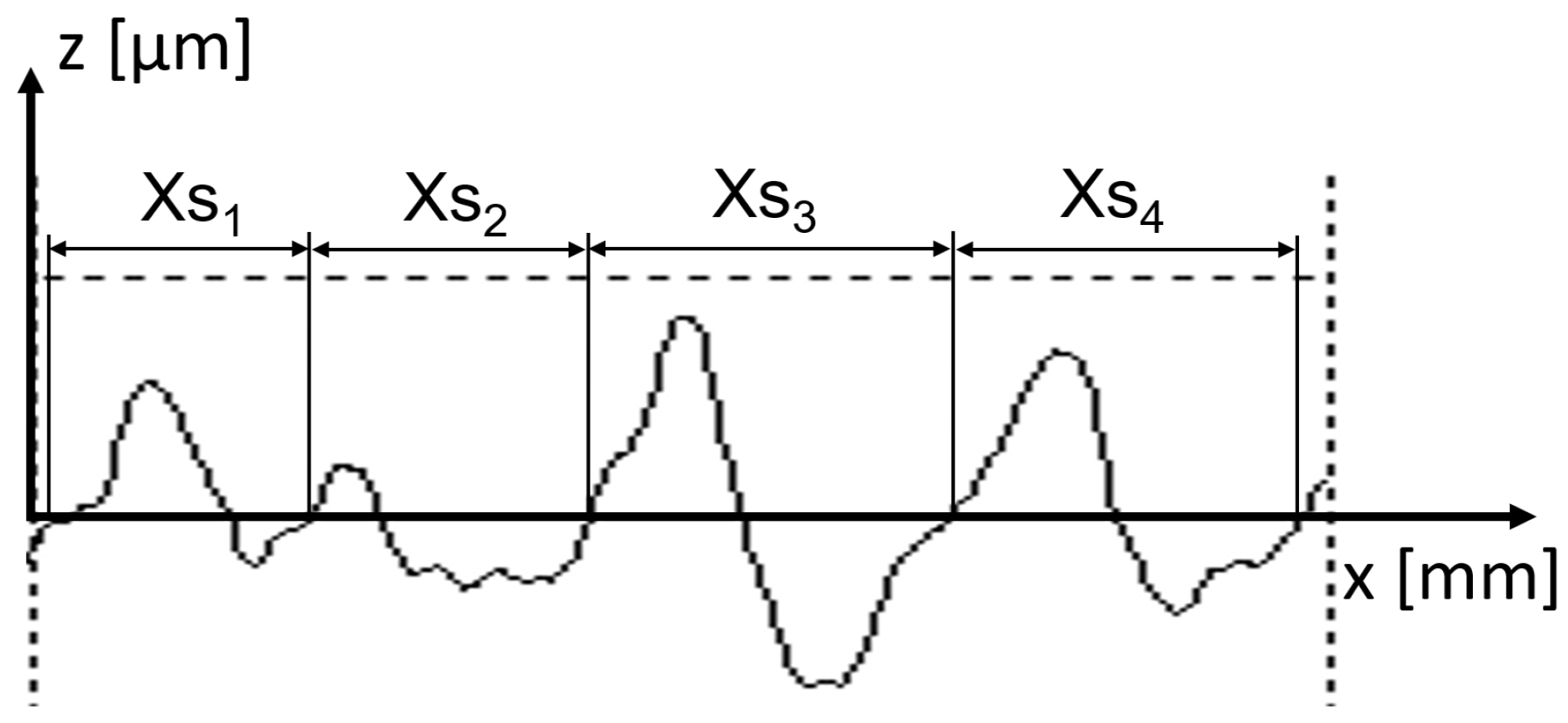
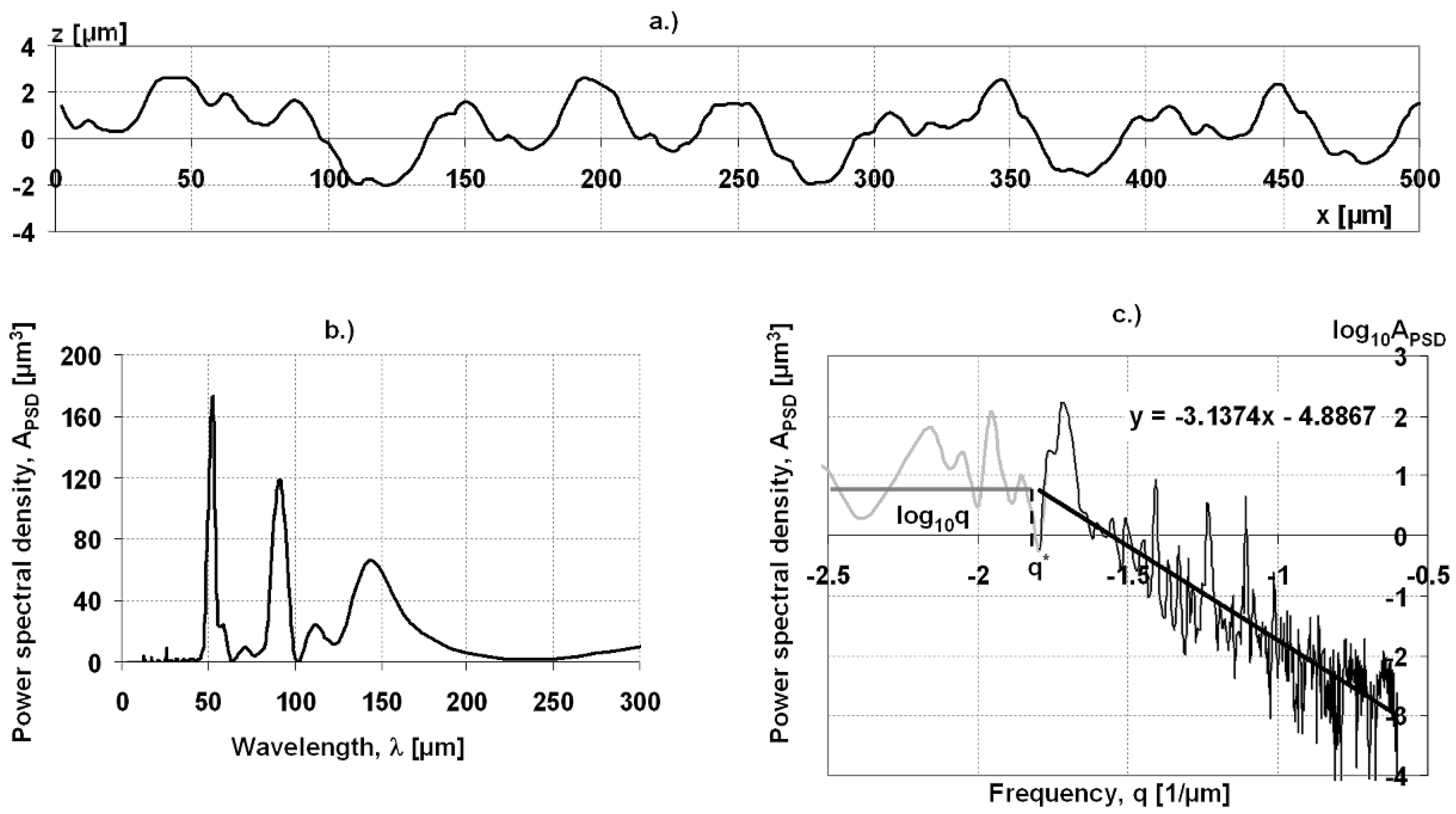


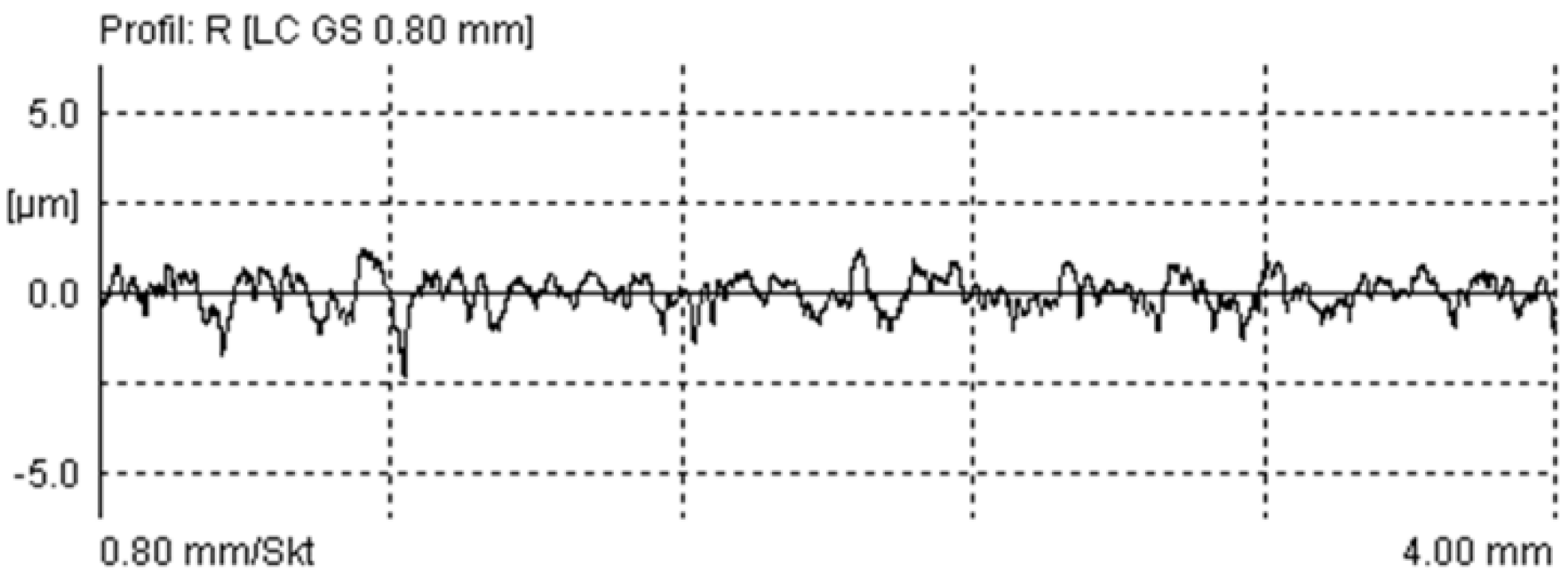

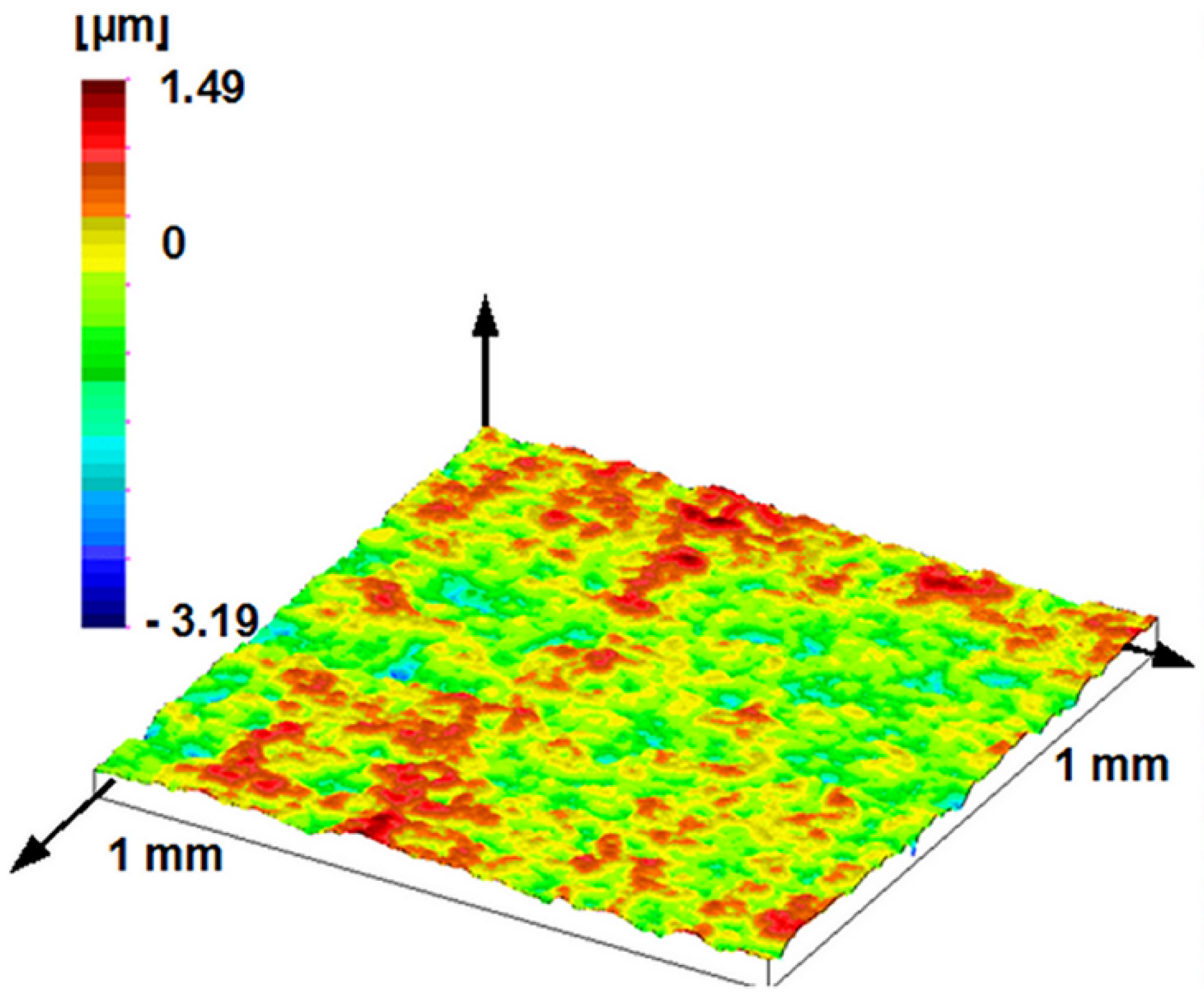
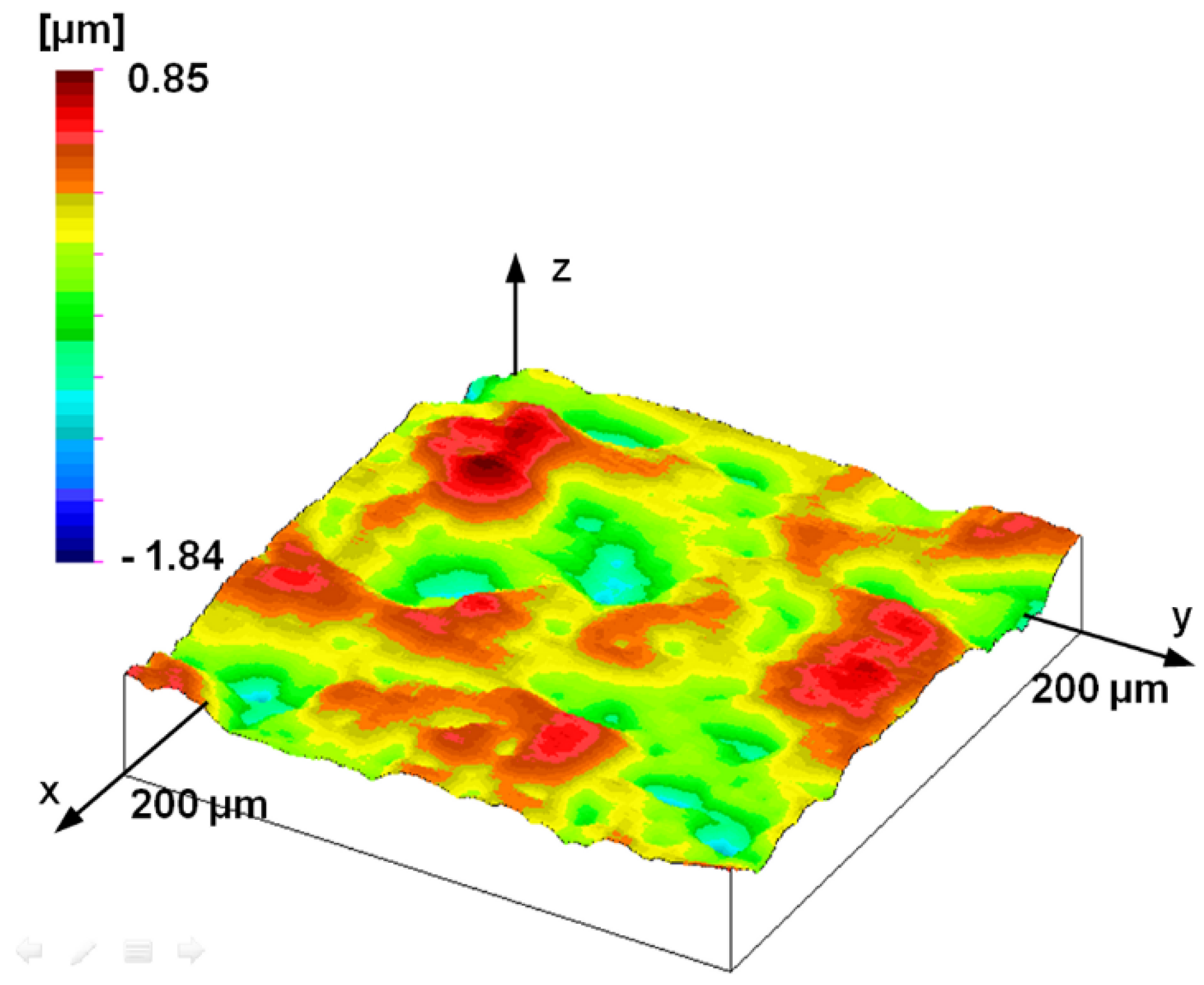

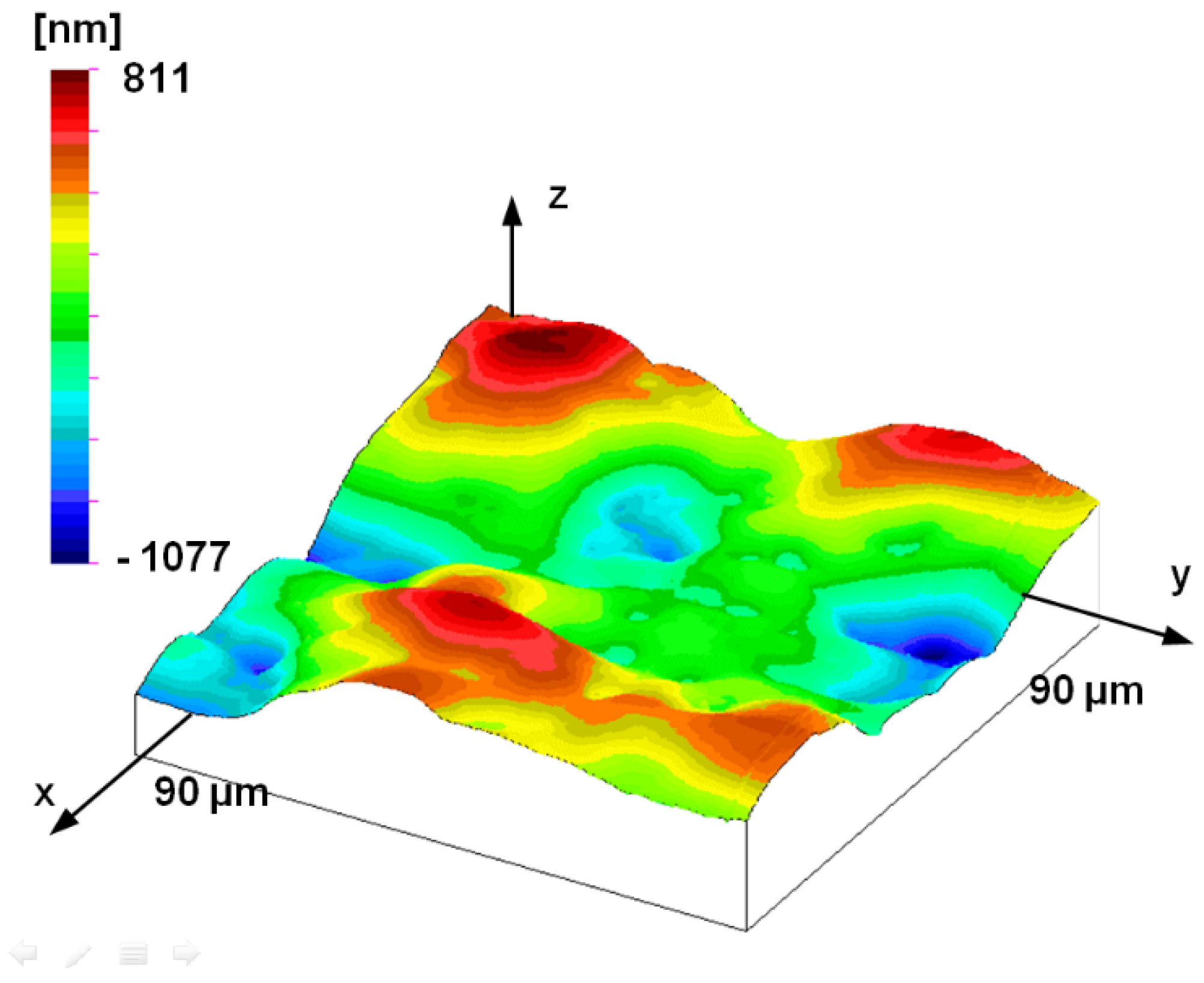
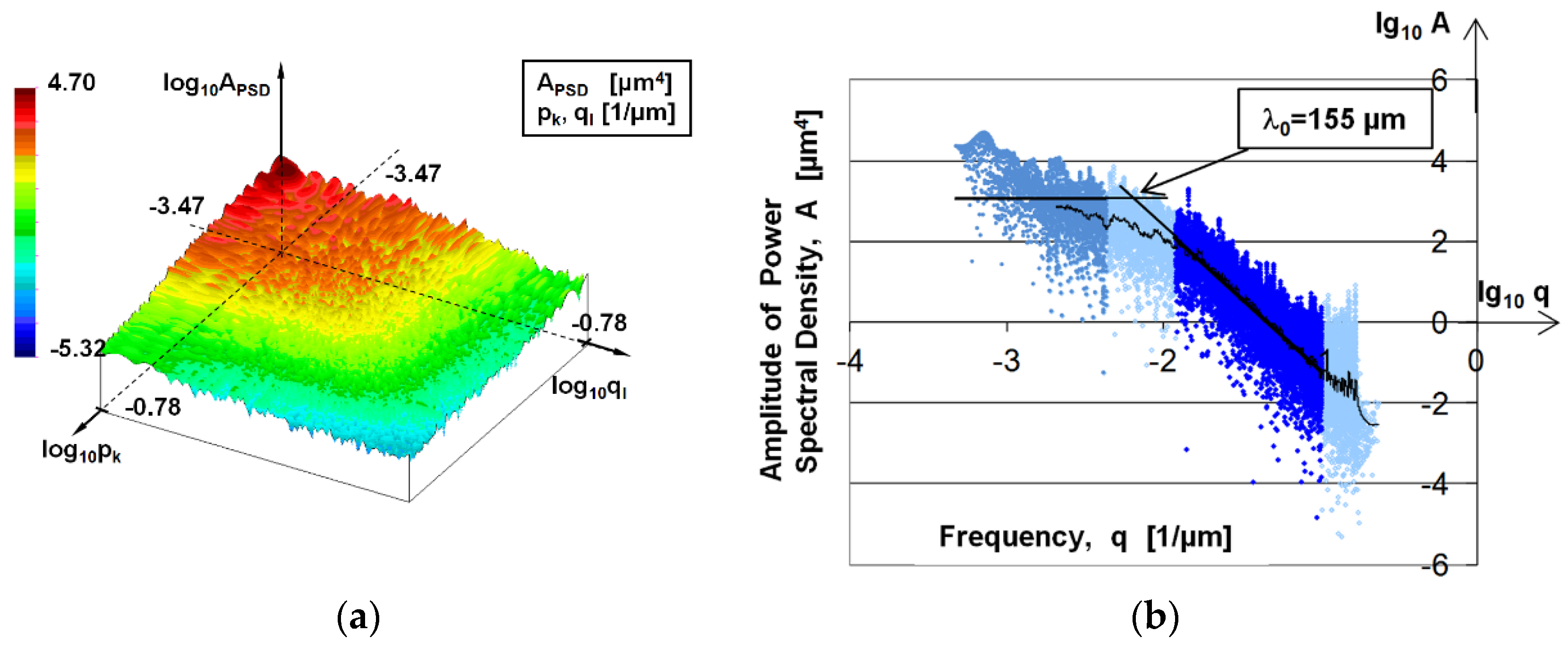
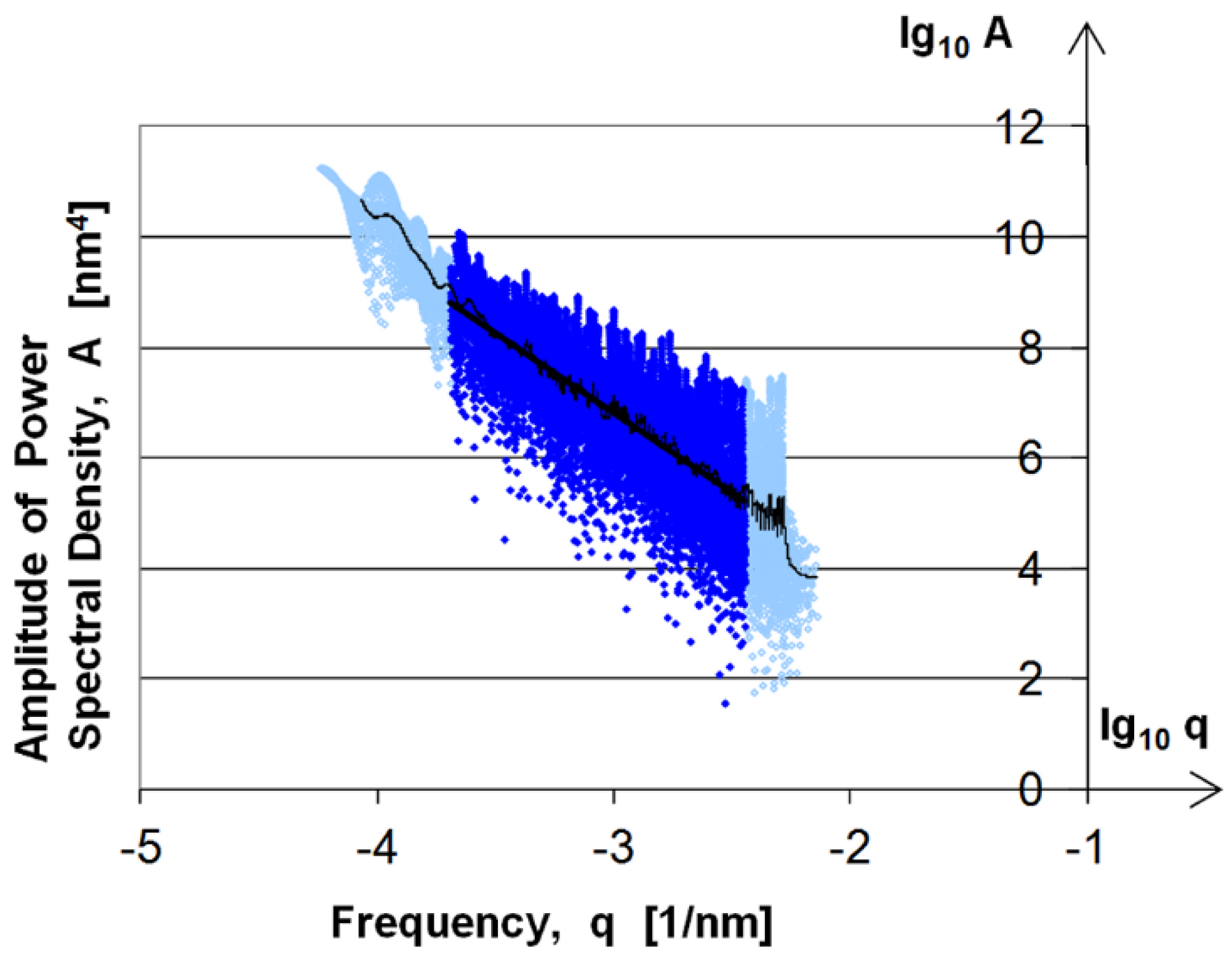
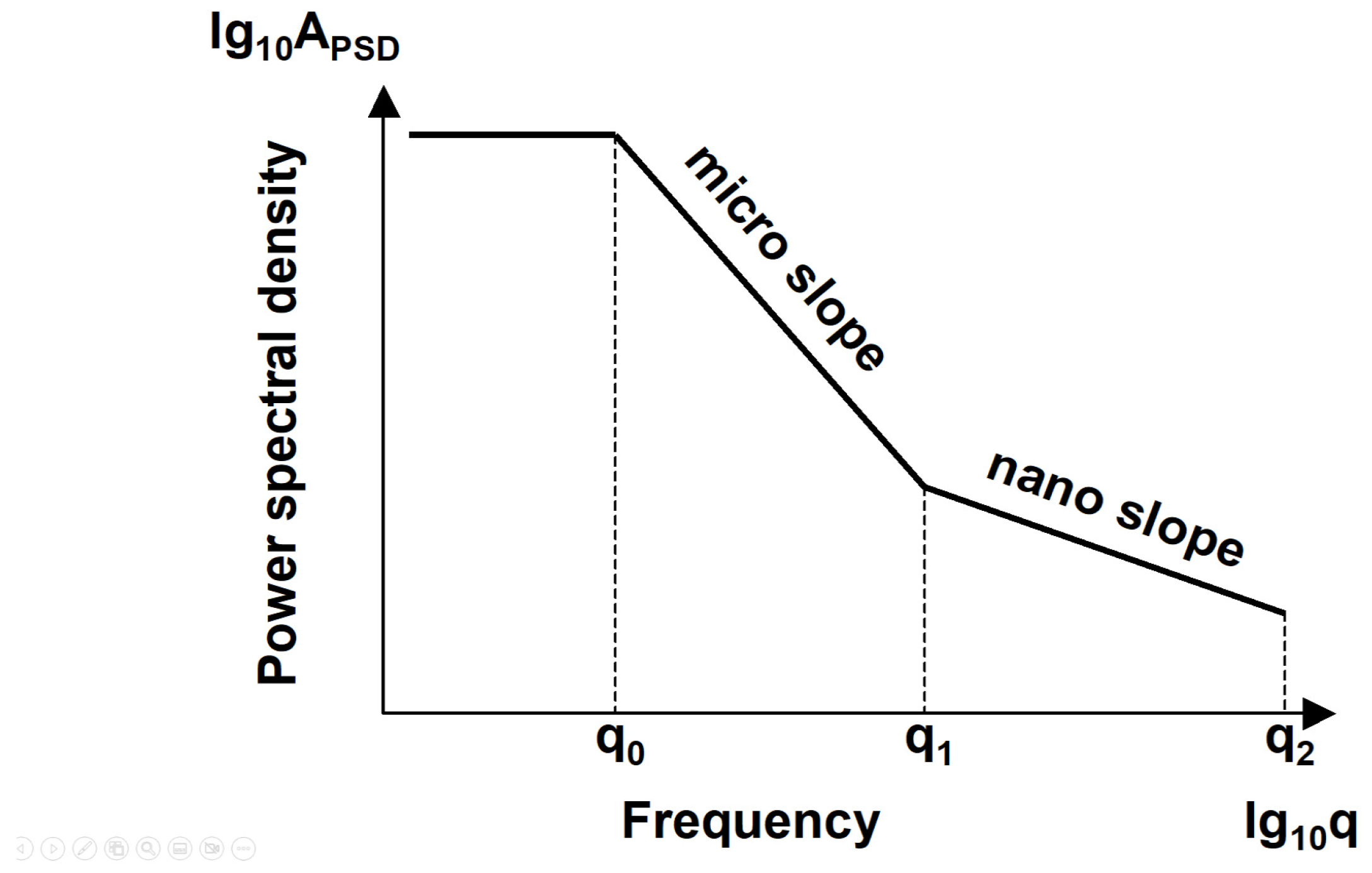
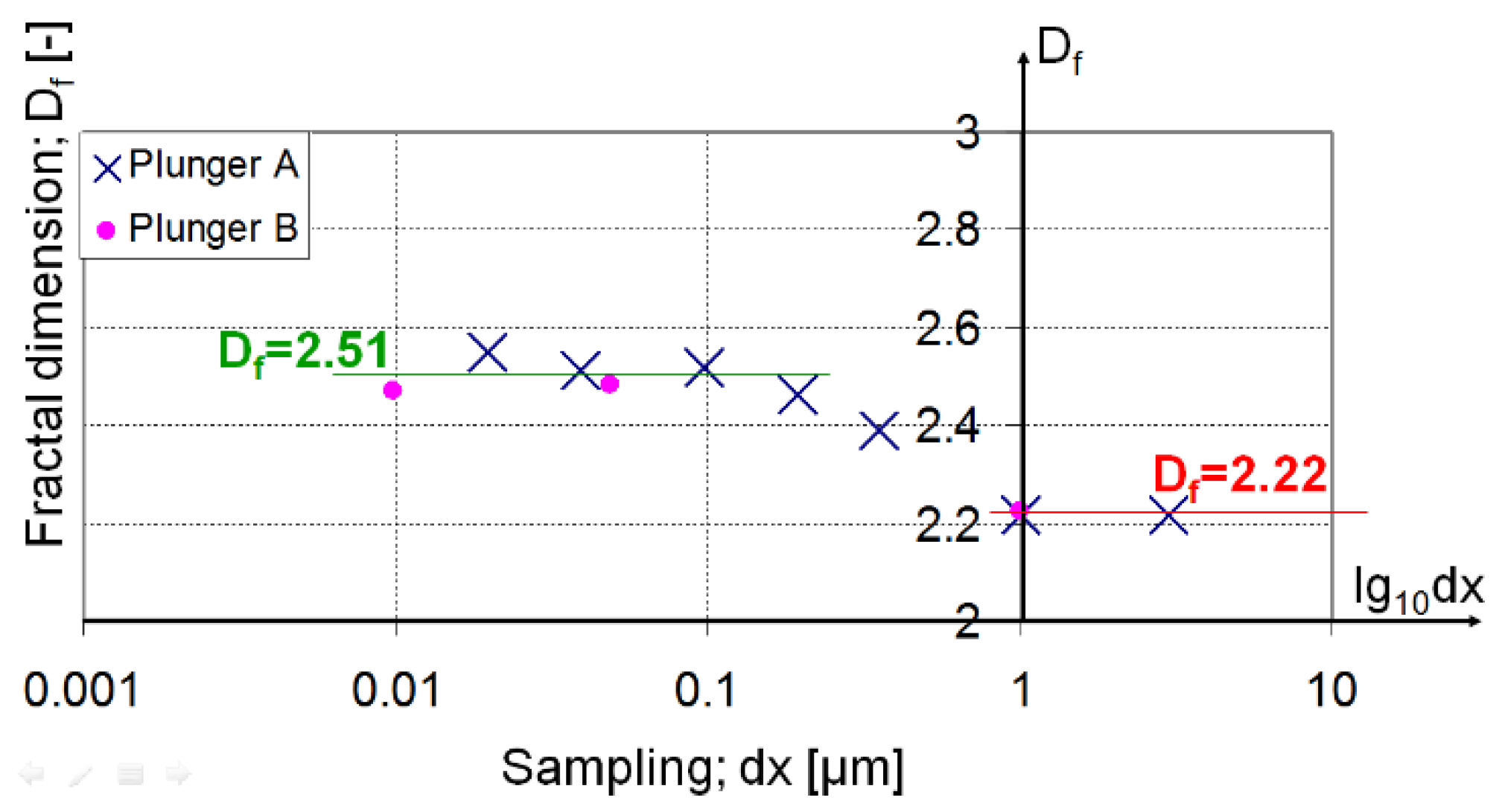
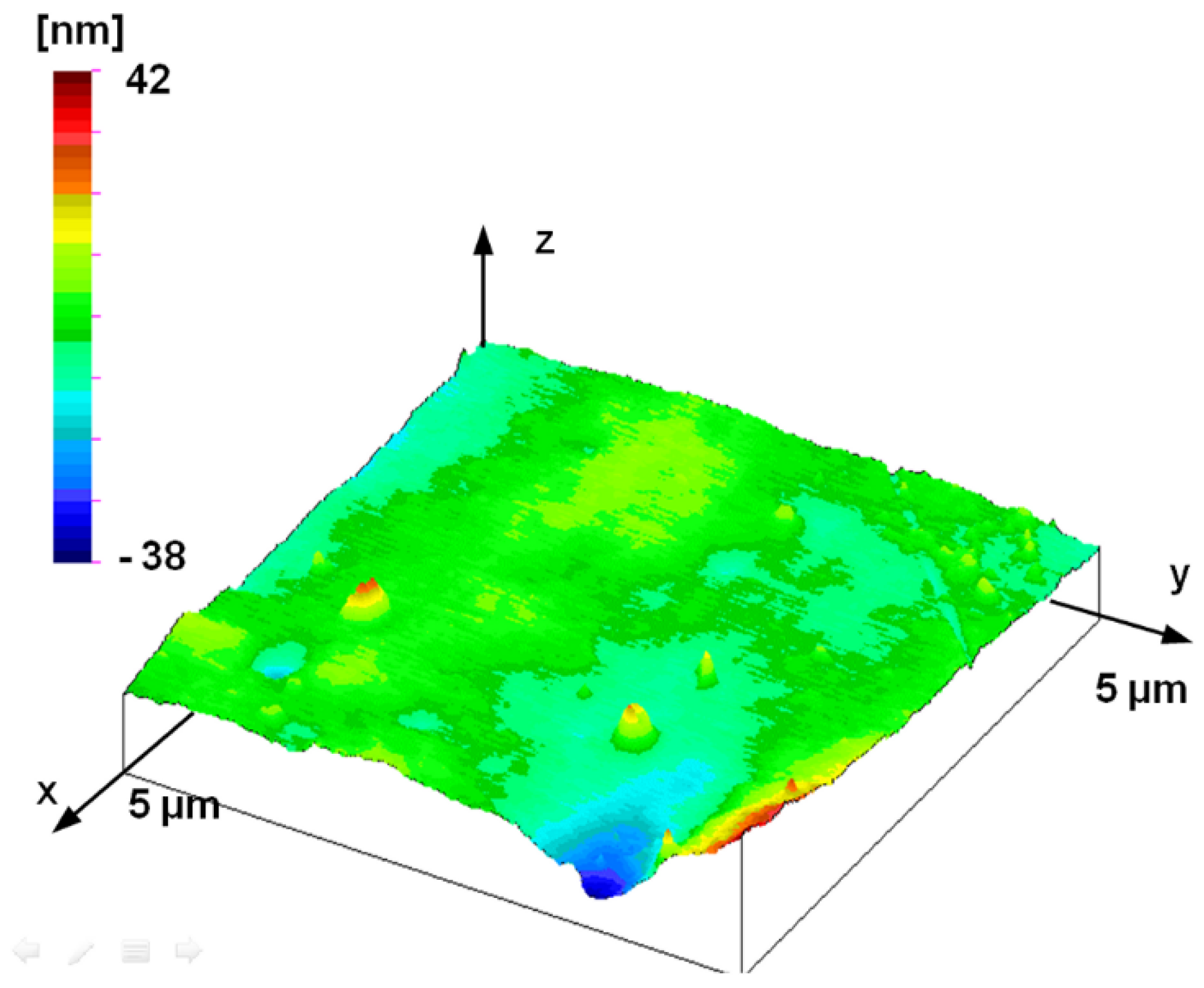
| Measuring Area µm2 | Sampling Distance nm | Number of Measurements | ||
|---|---|---|---|---|
| Plunger A | Plunger B | |||
| Stylus | 3000 × 3000 | 3000 | 1 | - |
| 1000 × 1000 | 1000 | 1 | 1 | |
| AFM | 90 × 90 | 352.9 | 2 | 1 |
| 50 × 50 | 196.1 | 1 | 1 | |
| 25 × 25 | 98.04 | 1 | 1 | |
| 10 × 10 | 39.21 | 1 | 1 | |
| 5 × 5 | 19.61 | 1 | 1 | |
| Applied Evaluation Technique | Dominant Wavelength [μm] |
|---|---|
| RSm parameter (2D profile) | 163.1 ± 24.6 |
| PSD analysis (2D profile) | 178 |
| Roughness peak test | 161 |
| Measurement | Sampling Distance [μm] | Frequency Range 1 [1/μm] | Analysed Frequency Range 2 [1/μm] | Fractal Dimension | Average Fractal Dimension | |
|---|---|---|---|---|---|---|
| Stylus | 3 × 3 mm | 3 | 0.00033–0.16 | 0.0118–0.1012 | 2.218 | 2.22 |
| 1 × 1 mm | 1 | 0.001–0.5 | 0.0164–0.2479 | 2.215 | ||
| AFM | 90 × 90 μm | 0.3529 | 0.0111–1.416 | 0.05635–0.9907 | 2.398 | 2.39 |
| 0.0670–0.8239 | 2.356 | |||||
| 0.05635–0.8239 | 2.420 | |||||
| 50 × 50 μm | 0.1961 | 0.02–2.549 | 0.1014–1.483 | 2.445 | 2.46 | |
| 0.1260–1.483 | 2.478 | |||||
| 25 × 25 μm | 0.0980 | 0.04–5.102 | 0.202–3.589 | 2.572 | 2.52 | |
| 0.252–2.967 | 2.458 | |||||
| 10 × 10 μm | 0.0392 | 0.1–12.75 | 0.507–7.415 | 2.552 | 2.51 | |
| 0.630–7.415 | 2.478 | |||||
| 5 × 5 μm | 0.0196 | 0.2–25.5 | 1.014–12.5 | 2.595 | 2.55 | |
| 1.260–12.5 | 2.498 | |||||
| Measurement | Hurst Exponent | |
|---|---|---|
| Stylus | 3 × 3 mm | 0.782 |
| 1 × 1 mm | 0.785 | |
| AFM | 90 × 90 μm | 0.602 |
| 0.644 | ||
| 0.580 | ||
| 50 × 50 μm | 0.555 | |
| 0.522 | ||
| 25 × 25 μm | 0.428 | |
| 0.542 | ||
| 10 × 10 μm | 0.448 | |
| 0.522 | ||
| 5 × 5 μm | 0.405 | |
| 0.502 | ||
Disclaimer/Publisher’s Note: The statements, opinions and data contained in all publications are solely those of the individual author(s) and contributor(s) and not of MDPI and/or the editor(s). MDPI and/or the editor(s) disclaim responsibility for any injury to people or property resulting from any ideas, methods, instructions or products referred to in the content. |
© 2024 by the authors. Licensee MDPI, Basel, Switzerland. This article is an open access article distributed under the terms and conditions of the Creative Commons Attribution (CC BY) license (https://creativecommons.org/licenses/by/4.0/).
Share and Cite
Czifra, Á.; Ancza, E. Micro- and Nano-Roughness Separation Based on Fractal Analysis. Materials 2024, 17, 292. https://doi.org/10.3390/ma17020292
Czifra Á, Ancza E. Micro- and Nano-Roughness Separation Based on Fractal Analysis. Materials. 2024; 17(2):292. https://doi.org/10.3390/ma17020292
Chicago/Turabian StyleCzifra, Árpád, and Erzsébet Ancza. 2024. "Micro- and Nano-Roughness Separation Based on Fractal Analysis" Materials 17, no. 2: 292. https://doi.org/10.3390/ma17020292






